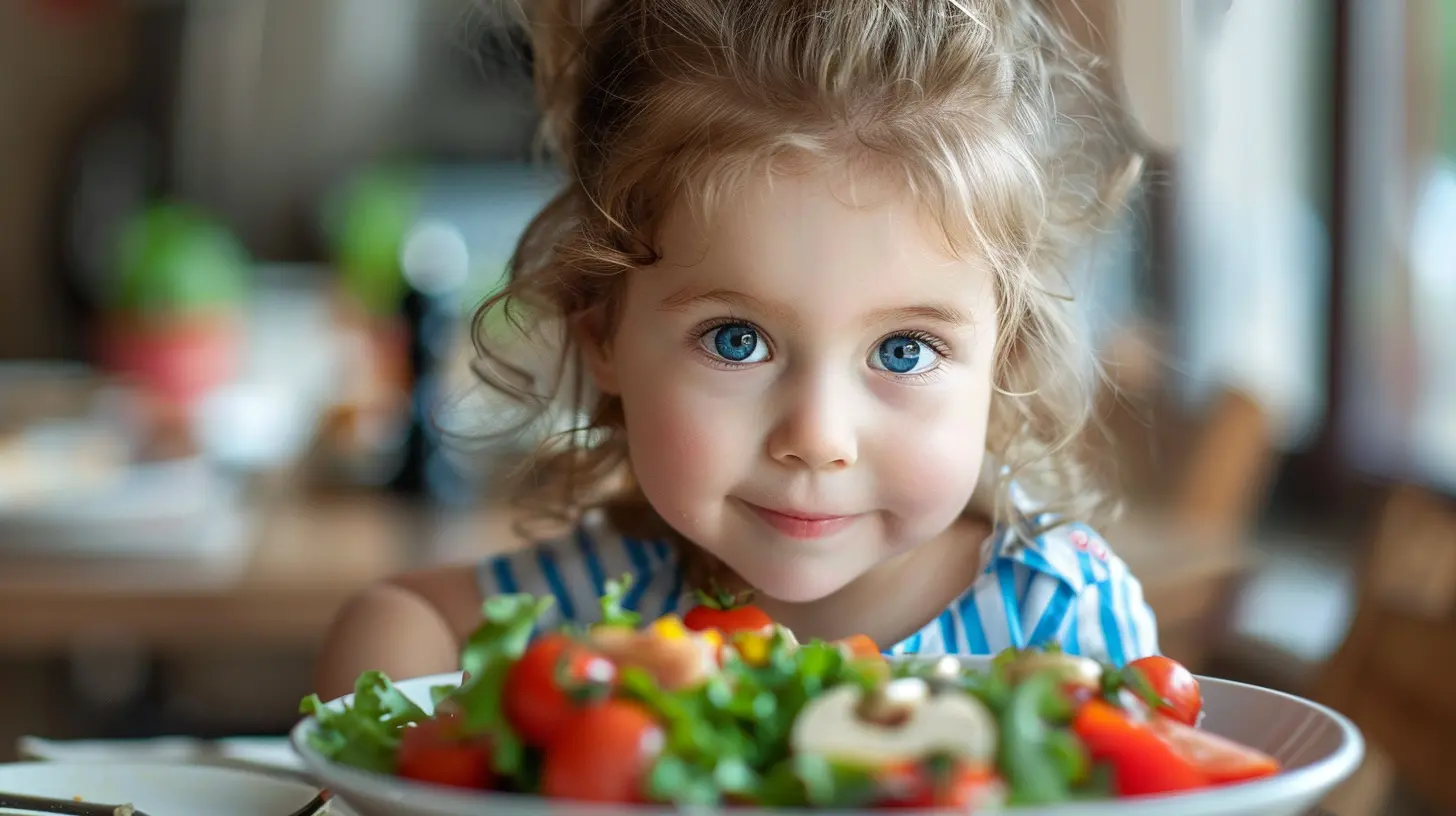Encouraging Mindful Eating in Toddlers and Beyond
17 November 2025
Every parent knows the struggle—your toddler refuses to eat anything but chicken nuggets, throws their veggies on the floor, or suddenly decides they hate their once-favorite food. Sound familiar? You're not alone.
But what if there was a way to make mealtime less stressful and more meaningful? Not just about getting food on the table but about helping your child develop a lifelong healthy relationship with food. Enter mindful eating.

What Is Mindful Eating?
Mindful eating is all about being present during meals—paying attention to hunger cues, savoring flavors, and eating with intention rather than out of habit or distraction. For toddlers (and even adults), it's a powerful way to build a positive connection with food.Think of it this way: Instead of just shoveling food in, mindful eating teaches kids to experience it fully. The taste, texture, and even emotions tied to eating become part of the process.

Why Is Mindful Eating Important for Kids?
In today’s fast-paced world, kids are often eating on the go, in front of screens, or being rushed through meals. Unfortunately, this can lead to overeating, poor digestion, and a weak connection to hunger cues.Teaching toddlers mindful eating has several benefits:
✔️ Encourages Healthy Eating Habits – Kids learn to appreciate a variety of foods and listen to their bodies.
✔️ Reduces Picky Eating – When toddlers engage with their food, they're more likely to try new things.
✔️ Prevents Overeating – Paying attention to hunger and fullness cues helps prevent emotional eating later in life.
✔️ Creates a Positive Mealtime Experience – Less stress, fewer tantrums, and more enjoyable family meals.
Sounds great, right? But how do we actually encourage mindful eating in toddlers and beyond? Let’s dive in.

1. Lead by Example
Kids are sponges—they absorb everything we do, including how we eat. If they see you scarfing down food while scrolling on your phone, they’ll likely do the same.So, take a deep breath and slow down. Show them what it means to enjoy a meal without distractions. Make a habit of talking about the flavors and textures of your food. A simple “Mmm, this apple is so crisp and sweet!” can make a big difference in how they approach their next bite.

2. Create a Calm Eating Environment
Distractions are the enemy of mindful eating. If the TV is blaring or toys are scattered all over the table, it’s hard for kids to focus on their plate.Try to create a dedicated mealtime space—a clean, quiet area where eating is the main event. Turn off screens, set the table, and make it a pleasant experience. This signals to your child that eating is important and deserves their attention.
3. Encourage Slow Eating
Toddlers are naturally speedy eaters. One minute their plate is full, the next—poof! It’s gone. Slowing things down helps them recognize when they’re truly full.Here’s how you can encourage a slower pace:
- Use smaller utensils – Toddlers love mimicking adults, so giving them child-sized forks and spoons helps them take smaller bites.
- Chew together – Turn it into a fun game: "Let's see if we can chew our bites 10 times before swallowing!"
- Pause between bites – Teach them to put their utensils down between bites instead of constantly shoveling food.
4. Teach Them to Listen to Their Hunger Cues
Kids are born with an incredible ability to regulate their eating. They eat when they’re hungry and stop when they’re full—something many adults struggle with!But forcing toddlers to "clean their plate" can override these natural cues. Instead, try this:
👶 Ask Questions – “Is your tummy still hungry, or do you feel full?”
🍽 Offer, Don’t Force – Present a variety of foods without pressuring them to eat everything.
🛑 Respect Their Fullness – If they say they’re full, trust them. Forcing food can lead to overeating habits later in life.
5. Make Mealtimes Engaging
Eating should be a joyful experience, not a battle. Making mealtime fun and engaging can encourage kids to be more mindful of what they’re eating.Try these ideas:
🎨 Play with Colors – "Can you find something red on your plate?"
👃 Smell Before Eating – Encourage them to take a deep sniff before taking a bite. It helps engage their senses.
👅 Describe Tastes and Textures – "Is your carrot crunchy or soft?"
These little activities keep their attention on the food in front of them.
6. Involve Them in Meal Prep
Kids are more likely to eat something they helped make. Get them involved, even if it’s as simple as stirring ingredients or laying out plates.When toddlers get to touch, smell, and see food being prepared, it sparks their curiosity and makes them more willing to try new things.
7. Introduce a Variety of Foods Without Pressure
Ever noticed that the more you push a food, the less likely your toddler is to eat it? Toddlers have a built-in resistance to being told what to do.Instead of saying, “Eat your broccoli,” try a different approach:
🍽 Offer it casually – Put it on their plate, but don’t make a big deal about it.
❓ Ask open-ended questions – "What does this taste like to you?"
⏳ Be patient – It can take multiple exposures before a child accepts a new food.
The goal is to create a positive food experience, not a power struggle.
8. Practice Gratitude for Food
Mindful eating also means appreciating where food comes from. Teaching kids gratitude for their meals can make them more conscious eaters.🧑🌾 Talk about how food grows and where it comes from.
🍎 Encourage them to thank whoever prepared the meal.
🌍 Discuss how food nourishes their body and gives them energy to play.
This simple habit makes mealtime feel special rather than just another daily chore.
9. Allow Some Independence
Giving toddlers a sense of control can make them more mindful eaters. Let them make small choices:🥦 "Would you like carrots or peas today?"
🍲 "Do you want your pasta with or without sauce?"
When kids feel like they have a say, they’re more likely to engage with their food rather than resist it.
10. Be Patient and Flexible
Mindful eating is a journey, not an overnight fix. Some days your toddler will happily munch on their veggies, and others they’ll refuse to eat anything that isn’t shaped like a dinosaur.That’s okay! The goal isn’t perfection—it’s progress. Keep practicing mindful eating habits, and over time, they’ll become second nature.
Final Thoughts
Encouraging mindful eating in toddlers (and beyond) is one of the greatest gifts you can give your child. It's not about strict rules or getting them to eat "perfectly," but about fostering a healthy, joyful relationship with food.By leading by example, creating distraction-free meals, and respecting their hunger cues, you're setting them up for a lifetime of balanced eating. And who knows? You might even find yourself becoming a more mindful eater along the way.
So, the next time your toddler sits down for a meal, take a deep breath, create a calm space, and enjoy the moment together. Because mealtime should be more than just eating—it should be an experience.
all images in this post were generated using AI tools
Category:
Childrens HealthAuthor:

Tiffany Foster
Discussion
rate this article
1 comments
Avery McCool
Mindful eating can greatly benefit toddlers by fostering healthy habits early on. Encourage them to pay attention to their hunger cues, enjoy meals without distractions, and explore a variety of foods. Make mealtime a positive, engaging experience to help cultivate their appreciation for nutritious choices throughout life.
November 17, 2025 at 5:38 AM


